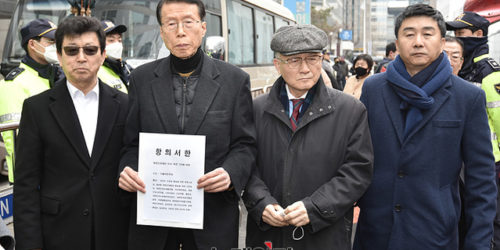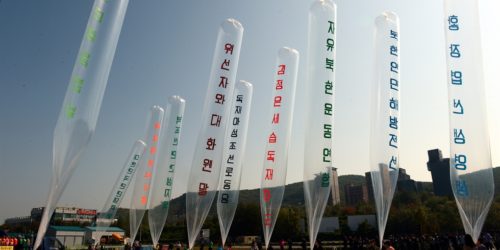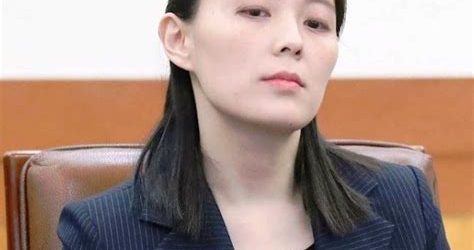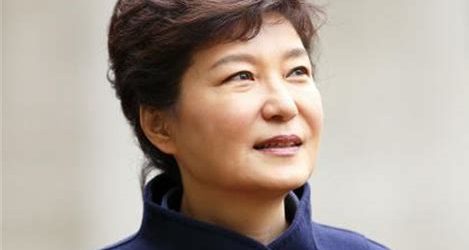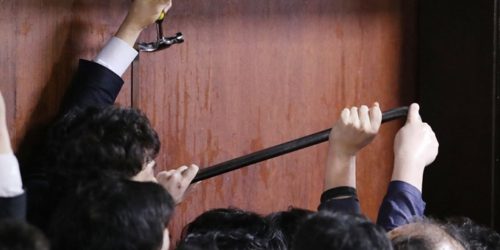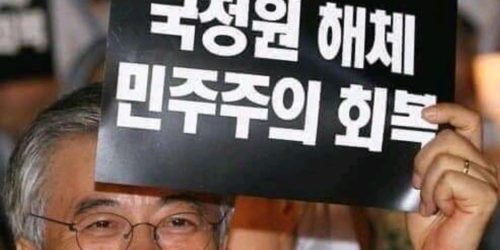Lee Seung-bok’s “I don’t like communism” and North Korean Operatives’ Massacre of Lee’s Family
2022-1-10, Tara O
Earlier this month, Chung Jin-yong (정진용), the Vice Chairman of Shinsegae Group posted “Defeat Communism,” on Instagram which Instagram censors removed, then later restored after attracting unfavorable media attention. Chung followed up by posting “I don’t like GongSanDang.” Although GongSanDang translates directly as communist party, it has a broader meaning of communism and communists as well, especially as these relate to North Korea.
The phrase “I don’t’ like GongSanDang” or “I don’t like communists/communism/communist party” is reminiscent of a statement said by a 9-year old boy, Lee Seung-bok (이승복), when he and his family were massacred by North Korean agents in 1968 in a poor village in Gangwon Province in the northeast part of South Korea.

This is a partial summary from a book titled “We Don’t Like Communism” by Kim Tae-soo, which is about a South Korean boy Lee Seung-bok, who, along with his family, was brutally murdered by North Korean armed agents, who infiltrated South Korea to build a Viet Cong-style revolutionary base in South Korea for armed revolts. These agents were referred to as “Gongbi” (공비). They are trained special forces sent to South Korea to remain there to conduct guerilla operations.
Lee Seung-bok (9) lived with his older brother Lee Hak-gwan (aka Seung-gwon) (15), younger brother Lee Seung-soo (7), younger sister Lee Seung-ja (4), mother Joo Dae-ha (34), father Lee Seok-woo (37), and grandmother. The family made a living growing corn on the hillside of the mountains.
On December 9, 1968, at least seven North Korean Gongbi wearing military uniform and carrying weapons went to Lee Seung-bok’s (이승복) house in the mountainside, probably in search of food, since it had been 40 days since they landed on the east coast of the Republic of Korea. The mother thought they were ROK soldiers, initially. They approached her to make some food for them. One of the communist operatives approached the boy and asked “Do you like North Korea or South Korea?” Without hesitation, Lee Seung-bok said, “We don’t like North Korea. (We/I) Don’t like GongSanDang.”
Immediately, the North Korean Gongbi lifted him by the neck, screaming at him. When his 15 year-old brother Lee Hak-gwan, surprised, tried to get up, another communist operative smashed Hak-gwan’s shoulder with the butt of his rifle. What Hak-gwan saw was another North Korean agent shoving a knife into the mouth of his younger brother, whose body was still dangling. Blood burst out of Lee Seung-bok as he screamed. The communist operatives stabbed and slashed Lee Hak-gwan, the older brother.
Lee’s mom, who was in the other room heard the screams, and Lee’s two younger siblings, who slept in the other room, were awakened. The North Korean agents each grabbed the 4 year-old and the 7 year-old, held them upside down, and swung their bodies against the wall, smashing their heads, multiple times.
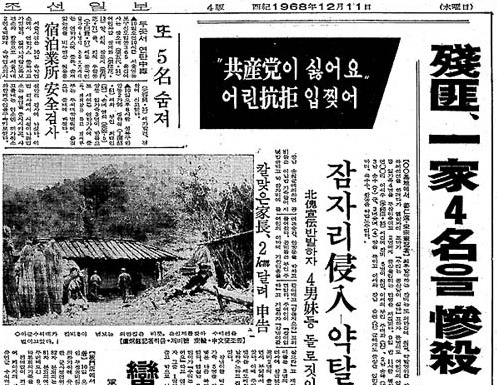
The communist operatives carried Lee Hak-gwan’s body outside, dumped him in a heap of manure (used as fertilizer), and stabbed his body some more, for a total of 36 times. Despite this, the eldest boy survived. His mother and his three siblings were gruesomely murdered, including Lee Seung-bok, who said he didn’t like GongSanDang. December 9, the day Lee Seung-bok was killed, was also his birthday.
Their father Lee Seok-woo left his friend’s house, leaving his mother behind, and returned to a dark home. Sensing something is not quite right, the father asked who was there. The North Korean agents tried to get him inside into a room. Lee Seok-woo smelled the blood and death and refused to go in. They tried to force him in, but then pulled him backwards, and when he fell, he saw them face-to-face and realized they were North Korean operatives. He quickly escaped through the kitchen out the small opening to the rear of the house, which was on top of a 10 meter-high cliff. He alerted the authorities, who mobilized the military and the police.
Meanwhile, Lee Hak-gwan, still conscious, got up after the Gongbi left, and went down to the nearest neighbor’s house, alerting them, and together, they evacuated to a house about 1 km away, alerting other families along the way. Choi Soon-ok (30), who saw Lee Hak-gwan, described Lee’s condition as bloody all over, with air coming out of his stab wounds on his back. She asked Lee questions and recall that he said his younger brother Seung-bok was killed by Gongbi, who stabbed and cut his brother’s mouth, because he said he didn’t like communism. Lee Hak-gwan eventually ended up at a military hospital in Wonju, and woke up three days later. First Lady Yuk Young-soo visited him at the hospital, encouraging him.
There were three other families that the North Korean operatives massacred. One occurred in Samcheok on November 14, 1968 to Choi Man-seok (86), his daughter-in-law Shin Wol-suool (52), his granddaughter Choi Yong-gab (15), who were stabbed with knives and crushed with the butt of rifles.
On November 20, 1968, the North Korean Gongbi murdered Koh Won-sik’s family in PyongChang while he was out, which included his father Koh Young-il (60), mother Lee Hyung-nyeo (61), wife Kim Myeong-soon (22), eldest daughter Koh Sang-oh (6), and the youngest daughter Koh Sang-keum (3). They were stabbed multiple times in the stomach and their heads were crushed by stone.
In Yongwol on November 25, 1968, four North Korean special operatives murdered Woo Tae-bong’s (27) family—his mother Park Ok-soon (50), his half-brother Kim Sang-gyu (12), and his eldest daughter Woo Young-ja (4). The North Korean Gongbi stabbed Woo Tae-bong’s wife Ahn Boon-nam (24) repeatedly in her stomach, while she was holding their 2-months old baby. Ahn survived, but was in critical condition.
The North Korean operatives murdered 31 villagers, including the families above. During the ROK military pursuit, 107 North Korean agents were killed, 5 arrested, and 2 turned themselves in.
The communist operatives were 120 of the top agents from North Korea’s 124th unit. The armed North Korean special operatives infiltrated South Korea through landings in the Uljin-Samcheok areas on the east coast over three days, October 30, November 1, and November 2, 1968. It was the third landing by swift boat that local fishermen noticed and they promptly reported it to the authorities. This infiltration was such a large-scale one that the South Korean military went on alert, supplementing the police with the military.
The North Korean special operatives’ mission was to establish a base in South Korea for armed uprisings. Their tasks were to:
- Infiltrate the Uljin County area, recruit locals or control villages and revolutionize the people and conduct intelligence collections on military targets
- Bring those deemed to be promising or have intelligence value to North Korea
- Use the weaknesses of South Korea to create and aggravate discontent.
- Punish turncoats and evil reactionary officials.
North Korea was encouraged by the communist guerilla operations of the Viet Cong (National Liberation Front of South Vietnam), which was a common front under the direction of North Vietnam, and wanted to replicate it in South Korea. It trained its elite forces, infiltrated them into South Korea with the goal of establishing a revolutionary base, and inciting and recruiting the locals in poor villages in South Korea. For guerilla operations to succeed, they must win the “hearts and minds” of the locals, and they were trained in this concept. They expected that the locals in South Korea would welcome them and support them with open arms. They were wrong. Most South Koreans were decidedly anti-communists, and reported them when they saw them. The operatives were sent to South Korea without much provisions, and they also began to face cold and hunger, while being pursued by the ROK military.
One of their first acts was to gather 46 people at Gosut village to take photos, distribute counterfeit money, and told them that soon there will be unification and they would then live well. They distributed propaganda booklets and forced the people to join the communist party (Korean Workers’ Party). For women, they told them to join the Minjoo Yeoseong Dongmaeng or YeoMaeng (Democratic Women’s League), a front organization under the control of the Korean Workers’ Party. When a villager Jeon Byong-doo refused to join the Party, the North Korean operatives killed him by stabbing him with knives numerous times and smashed his face with a stone. They repeated this in other villages.
In 1968, about 1,262 North Korean armed special operatives infiltrated or attempt to infiltrate South Korea, including 1,087 attempts through the DMZ, 15 to the southern island of Jeju, and about 160 to the rear area (including the 120 who landed in the Uljin-Samcheok area). These were confirmed cases.
In 1968, these key events also occurred:
January 21: The Blue House Raid. North Korea sent 31 commandos from Unit 124 to South Korea to assassinate President Park Chung-hee. They failed, and one, Lieutenant Kim Shin-jo, was captured alive.
January 28: North Korea captured the USS Pueblo in international waters and abducted 83 crew members (1 was killed during the attack) on board, holding them hostage for 11 months. The ship the USS Pueblo still remains in North Korea.
(January 31, 1968 was the Tet Offensive in Vietnam.)
As we can see North Korea was highly active during 1968. Their heinous, unnecessary brutality has left a bitter taste in the mouths of many South Koreans, and they had strong anti-communism consciousness. Starting 1990s, however, Lee Seung-bok’s story, as well as anti-communism, began to be de-emphasized greatly to the point most younger Koreans have not heard of Lee Seung-bok, and anti-communism has been deemed to be an outdated concept. Chung Jin-yong has brought back the statement “I don’t like communism,” which is receiving positive public feedback in South Korea, and one must ask why. This viral meme revisits the past and shows that despite efforts to erase history, there is still resistance to communism.
